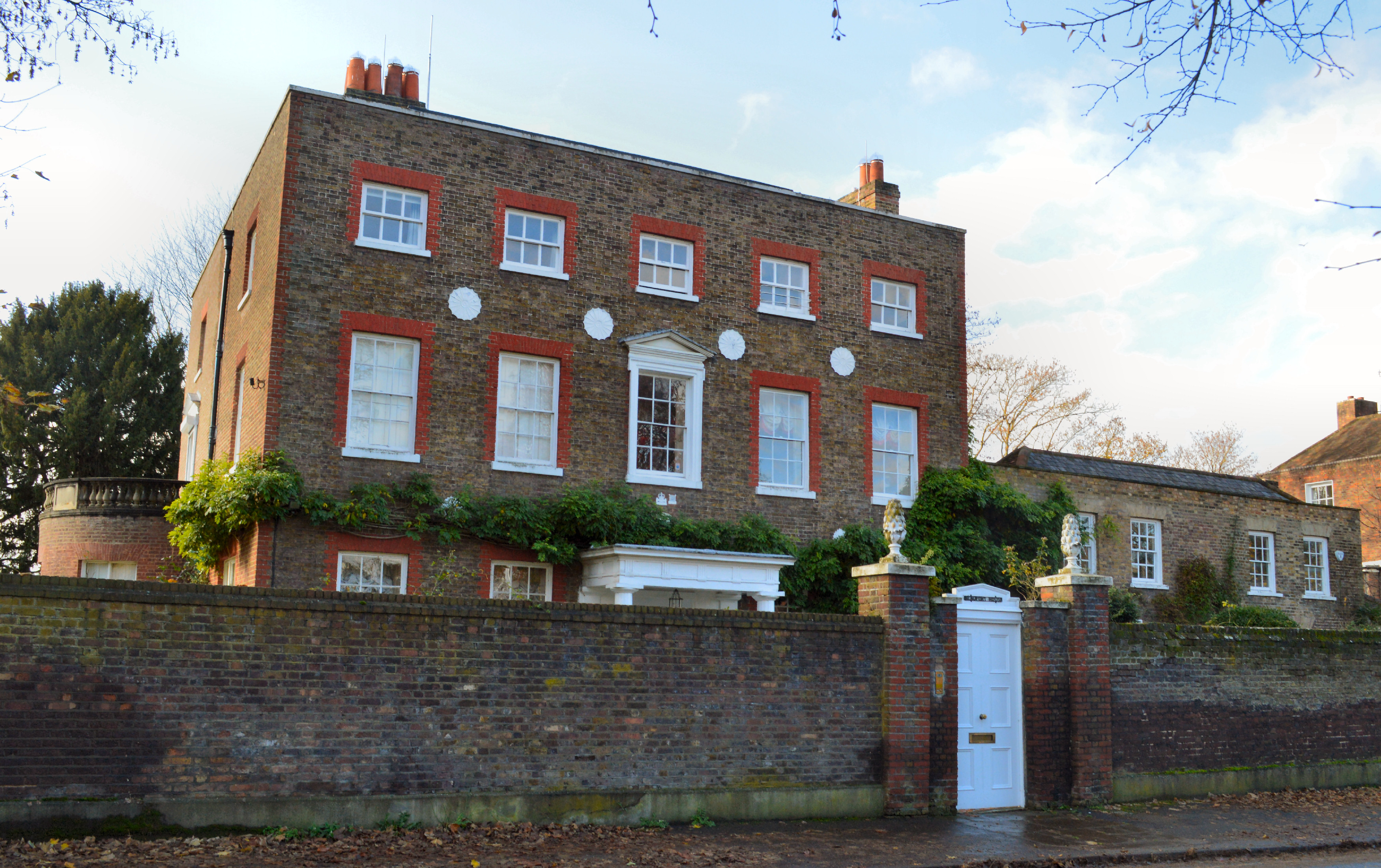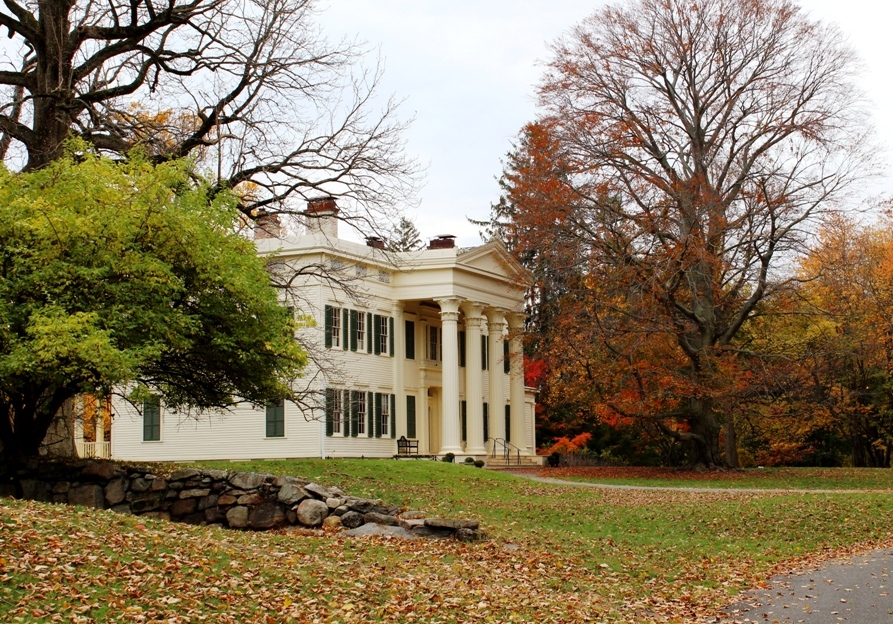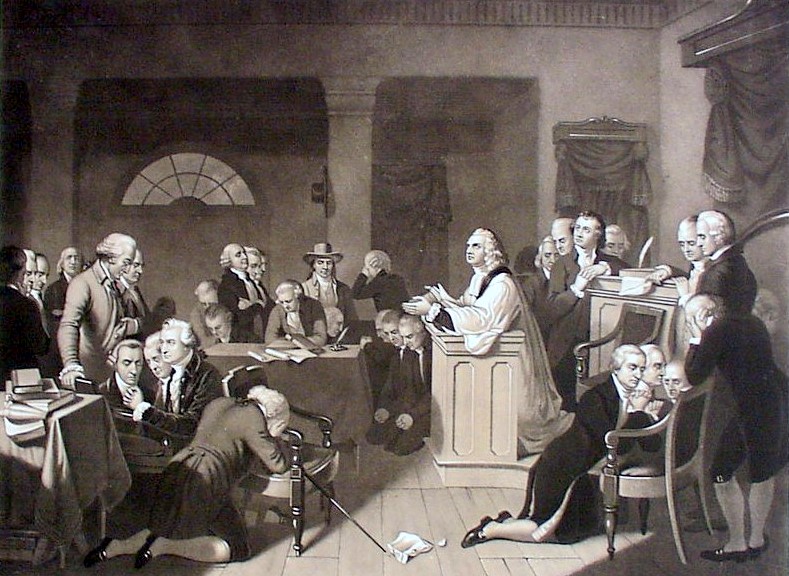|
Lady Juliana Fermor Penn
Lady Juliana Penn (; May 21, 1729 – November 20, 1801) was the English wife of Thomas Penn, and she assisted him in the administration of the Colony of Pennsylvania in his later years. She corresponded with John Adams and other leaders of the early United States. Early life Lady Juliana was born in 1729, at Easton Neston, Northamptonshire, the fourth daughter of Thomas Fermor, 1st Earl of Pomfret and Henrietta Louisa Jeffreys. Marriage, family, and colonial relations Juliana Fermor and Thomas Penn married on August 22, 1751. Lady Juliana was almost thirty years her husband's junior. After their marriage, Thomas Penn (formerly a Quaker) attended Anglicanism, Anglican church services regularly, though he did not take part in the sacrament of Eucharist, Communion. The Penns lived at Stoke Park, Buckinghamshire. The Penns had eight children; four of them died in infancy or childhood, and daughter Juliana died in childbirth at age 19. Thomas Penn experienced declining health in th ... [...More Info...] [...Related Items...] OR: [Wikipedia] [Google] [Baidu] |
Arthur Devis
Arthur Devis (19 February 1712 – 25 July 1787) was an English artist, half-brother of the painter Anthony Devis (1729–1816), and father of painters Thomas Anthony Devis (1757–1810) and Arthur William Devis (1762–1822). His place in the pages of art history is generally as a painter of the type of portrait now called a conversation piece. Arthur was taught by the Flemish painter Peter Tillemans. Though his early work was in part as a landscape artist, he also drew upon family connections to win clientele for portraits of the members of pro-Jacobite Lancashire families. In fact, by 1737 he had gravitated to portrait painting, setting up a studio in London. In London Devis acquired a considerable reputation, though his success was to follow a certain parabola. Faced with other fashionable artistic currents represented by the work of such painters as Joshua Reynolds and Johann Zoffany, his commissions declined and he was obliged to move to restoring pictures. His ma ... [...More Info...] [...Related Items...] OR: [Wikipedia] [Google] [Baidu] |
American Revolutionary War
The American Revolutionary War (April 19, 1775 – September 3, 1783), also known as the Revolutionary War or American War of Independence, was a major war of the American Revolution. Widely considered as the war that secured the independence of the United States, fighting began on April 19, 1775, followed by the Lee Resolution on July 2, 1776, and the Declaration of Independence on July 4, 1776. The American Patriots were supported by the Kingdom of France and, to a lesser extent, the Dutch Republic and the Spanish Empire, in a conflict taking place in North America, the Caribbean, and the Atlantic Ocean. Established by royal charter in the 17th and 18th centuries, the American colonies were largely autonomous in domestic affairs and commercially prosperous, trading with Britain and its Caribbean colonies, as well as other European powers via their Caribbean entrepôts. After British victory over the French in the Seven Years' War in 1763, tensions between the motherland and he ... [...More Info...] [...Related Items...] OR: [Wikipedia] [Google] [Baidu] |
Lancaster, Pennsylvania
Lancaster, ( ; pdc, Lengeschder) is a city in and the county seat of Lancaster County, Pennsylvania. It is one of the oldest inland cities in the United States. With a population at the 2020 census of 58,039, it ranks 11th in population among Pennsylvania's municipalities. The Lancaster metropolitan area population is 507,766, making it the 104th-largest metropolitan area in the U.S. and second-largest in the South Central Pennsylvania area. The city's primary industries include healthcare, tourism, public administration, manufacturing, and both professional and semi-professional services. Lancaster is a hub of Pennsylvania's Dutch Country. Lancaster is located southwest of Allentown and west of Philadelphia. History Originally called Hickory Town, the city was renamed after the English city of Lancaster by native John Wright. Its symbol, the red rose, is from the House of Lancaster. Lancaster was part of the 1681 Penn's Woods Charter of William Penn, and was laid ... [...More Info...] [...Related Items...] OR: [Wikipedia] [Google] [Baidu] |
Arthur Devis (1712–1787)
Arthur Devis (19 February 1712 – 25 July 1787) was an English artist, half-brother of the painter Anthony Devis (1729–1816), and father of painters Thomas Anthony Devis (1757–1810) and Arthur William Devis (1762–1822). His place in the pages of art history is generally as a painter of the type of portrait now called a conversation piece. Arthur was taught by the Flemish painter Peter Tillemans. Though his early work was in part as a landscape artist, he also drew upon family connections to win clientele for portraits of the members of pro-Jacobite Lancashire families. In fact, by 1737 he had gravitated to portrait painting, setting up a studio in London. In London Devis acquired a considerable reputation, though his success was to follow a certain parabola. Faced with other fashionable artistic currents represented by the work of such painters as Joshua Reynolds and Johann Zoffany, his commissions declined and he was obliged to move to restoring pictures. His mar ... [...More Info...] [...Related Items...] OR: [Wikipedia] [Google] [Baidu] |
Joshua Reynolds
Sir Joshua Reynolds (16 July 1723 – 23 February 1792) was an English painter, specialising in portraits. John Russell said he was one of the major European painters of the 18th century. He promoted the "Grand Style" in painting which depended on idealization of the imperfect. He was a founder and first president of the Royal Academy of Arts, and was knighted by George III in 1769. Early life Reynolds was born in Plympton, Devon, on 16 July 1723 the third son of the Rev. Samuel Reynolds, master of the Plympton Free Grammar School in the town. His father had been a fellow of Balliol College, Oxford, but did not send any of his sons to the university. One of his sisters was Mary Palmer (1716–1794), seven years his senior, author of ''Devonshire Dialogue'', whose fondness for drawing is said to have had much influence on him when a boy. In 1740 she provided £60, half of the premium paid to Thomas Hudson the portrait-painter, for Joshua's pupilage, and nine years later a ... [...More Info...] [...Related Items...] OR: [Wikipedia] [Google] [Baidu] |
Stoke Poges
Stoke Poges () is a village and civil parish in south-east Buckinghamshire, England. It is centred north-north-east of Slough, its post town, and southeast of Farnham Common. Etymology In the name Stoke Poges, ''stoke'' means " stockaded (place)" that is staked with more than just boundary-marking stakes. In the 1086 ''Domesday Book'', the village was recorded as ''Stoche''. William Fitz-Ansculf, who held the manor in 1086 (in the grounds of which the Norman parish church was built), later became known as William Stoches or William of Stoke. Amicia of Stoke, heiress to the manor, married Robert Pogeys, Knight of the Shire 200 years later, and the village eventually became known as Stoke Poges. Robert Poges was the son of Savoyard Imbert Pugeys, valet to King Henry III and later steward of the royal household. Poges and Pocheys being an English attempt at Pugeys which ironically meant "worthless thing". The spelling appearing as "Stoke Pocheys", if applicable to this villag ... [...More Info...] [...Related Items...] OR: [Wikipedia] [Google] [Baidu] |
Ham, London
Ham is a suburban district in Richmond, south-west London. It has meadows adjoining the River Thames where the Thames Path National Trail also runs. Most of Ham is in the London Borough of Richmond upon Thames and, chiefly, within the ward of Ham, Petersham and Richmond Riverside; the rest is in the Royal Borough of Kingston upon Thames. The district has modest convenience shops and amenities, including a petrol station and several pubs, but its commerce is subsidiary to the nearby regional-level economic centre of Kingston upon Thames. Geography Ham is centred south-west of the centre of London. Together with Petersham, Ham lies east of the bend in the river almost surrounding it on three sides, south of Richmond and north of Kingston upon Thames. Its elevation mostly ranges between 6m and 12m OD but reaches 20m in the foothill side-streets leading to Richmond Park. It has the Thames Path National Trail and is connected to Teddington by a large Lock Footbridge at Teddin ... [...More Info...] [...Related Items...] OR: [Wikipedia] [Google] [Baidu] |
Beaufort House
Beaufort House is an 18th-century grade II listed house in Ham, near Richmond, Surrey. History Beaufort House was built in about 1780. It was originally the dower house to Ham House. In about 1855, a private Catholic girls school moved to Beaufort House. In 1856, St Mary's Catholic Chapel was set up in its grounds, with a separate entrance for the public, and closed in 1870, when the school moved to Notting Hill. The house was listed grade II in 1983. Notable residents Lady Juliana Fermor Penn lived there until her death in 1801. Admiral Sir William Parker, 1st Baronet, of Harburn died in 1802 at Beaufort House, which was his country estate when he was not living at 12 Crooms Hill, Greenwich. In 1901, Dr William Simpson Craig (1822-1893), the father of the psychiatrist Sir Maurice Craig and politician Norman Craig was living there, as was Norah Palmer Holroyd, an ancestor of Michael Holroyd. From 1907 to 1920, Craig's son-in-law, Dr Macnamara (and his wife) lived there. ... [...More Info...] [...Related Items...] OR: [Wikipedia] [Google] [Baidu] |
Treaty Of Paris (1783)
The Treaty of Paris, signed in Paris by representatives of George III, King George III of Kingdom of Great Britain, Great Britain and representatives of the United States, United States of America on September 3, 1783, officially ended the American Revolutionary War and overall state of conflict between the two countries. The treaty set the Demarcation line, boundaries between the British North America (later called Canada) and the United States, United States of America, on lines "exceedingly generous" to the latter. Details included fishing rights and restoration of property and Prisoners of war in the American Revolutionary War, prisoners of war. This treaty and the separate peace treaties between Great Britain and the nations that supported the American cause—France in the American Revolutionary War, France, Spain in the American Revolutionary War, Spain, and the Dutch Republic—are known collectively as the Peace of Paris (1783), Peace of Paris. Only Article 1 of the tr ... [...More Info...] [...Related Items...] OR: [Wikipedia] [Google] [Baidu] |
John Jay
John Jay (December 12, 1745 – May 17, 1829) was an American statesman, patriot, diplomat, abolitionist, signatory of the Treaty of Paris, and a Founding Father of the United States. He served as the second governor of New York and the first chief justice of the United States. He directed U.S. foreign policy for much of the 1780s and was an important leader of the Federalist Party after the ratification of the United States Constitution in 1788. Jay was born into a wealthy family of merchants and New York City government officials of French Huguenot and Dutch descent. He became a lawyer and joined the New York Committee of Correspondence, organizing American opposition to British policies such as the Intolerable Acts in the leadup to the American Revolution. Jay was elected to the First Continental Congress, where he signed the Continental Association, and to the Second Continental Congress, where he served as its president. From 1779 to 1782, Jay served as the ambassador ... [...More Info...] [...Related Items...] OR: [Wikipedia] [Google] [Baidu] |
Benjamin Franklin
Benjamin Franklin ( April 17, 1790) was an American polymath who was active as a writer, scientist, inventor, statesman, diplomat, printer, publisher, and political philosopher. Encyclopædia Britannica, Wood, 2021 Among the leading intellectuals of his time, Franklin was one of the Founding Fathers of the United States, a drafter and signer of the United States Declaration of Independence, and the first United States Postmaster General. As a scientist, he was a major figure in the American Enlightenment and the history of physics for his studies of electricity, and for charting and naming the current still known as the Gulf Stream. As an inventor, he is known for the lightning rod, bifocals, and the Franklin stove, among others. He founded many civic organizations, including the Library Company, Philadelphia's first fire department, and the University of Pennsylvania. Isaacson, 2004, p. Franklin earned the title of "The First American" for his early and indefa ... [...More Info...] [...Related Items...] OR: [Wikipedia] [Google] [Baidu] |
Jacob Duché
The Reverend Jacob Duché (1737–1798) was a Rector of Christ Church in Philadelphia, Pennsylvania, and the first chaplain to the Continental Congress. Biography Duché was born in Philadelphia in 1737, the son of Colonel Jacob Duché, Sr., later mayor of Philadelphia (1761–1762) and grandson of Anthony Duché, a French Huguenot. He was educated at the Philadelphia Academy and then in the first class of the College of Philadelphia (now the University of Pennsylvania), where he also worked as a tutor of Greek and Latin. After graduating as valedictorian in 1757, he studied briefly at Cambridge University before being ordained an Anglican clergyman by the Bishop of London and returning to the colonies. In 1759 he married Elizabeth Hopkinson, sister of Francis Hopkinson, a signer of the Declaration of Independence. In 1768, he was elected to the American Society. Duché first came to the attention of the First Continental Congress in September 1774, when he was summoned to Ca ... [...More Info...] [...Related Items...] OR: [Wikipedia] [Google] [Baidu] |





.jpg)


